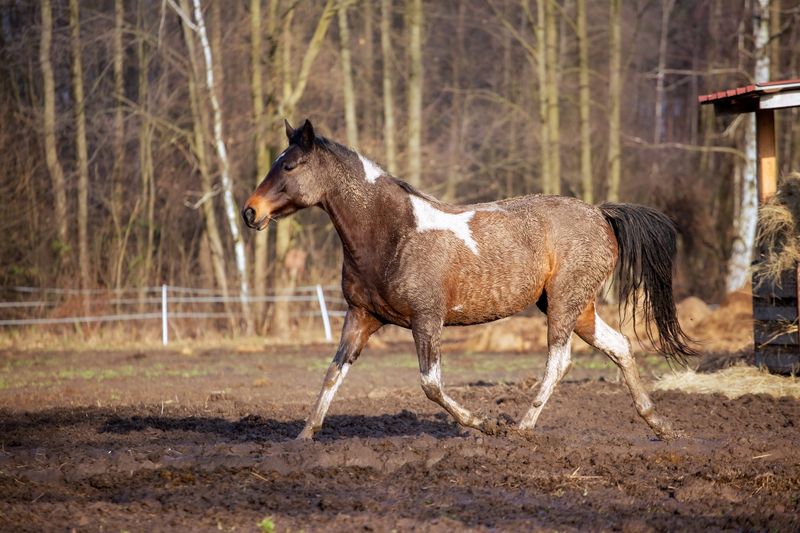Mud Happens — Plan for It
Keeps Hooves Dry & Pastures Cleaner


If you have horses, chances are that you (sometimes) have mud. In fact, it’s an almost inevitable part of horse keeping in the spring and early summer. Thankfully, there are steps you can take to help minimize the impact of mud as well as to cope when it is problematic.
Try an Alternate Gate
Horses naturally gravitate to entry points because that’s where they come and go — and where they expect you to appear (hopefully with food and treats.) Unfortunately, all that activity takes a toll on the ground. Vegetation gets trampled, soil compacts and before long, you’re dealing with a muddy mess.
One effective way to reduce wear is to add a secondary access point to your pasture, ideally some distance away from the original. You don’t have to use it year-round, but during mud season, rotating entry areas can give the overused zone a break and help preserve your pasture.
Create A Sacrifice Paddock
When spring mud becomes widespread, it can take a toll on the entire pasture. In these cases, horse owners may benefit from creating a designated “sacrifice” paddock to use during the wet season. The concept is simple: if mud is inevitable, it’s better to confine the damage to a small, manageable area. By limiting traffic to this section, you’ll protect the rest of the pasture and help it stay usable longer — meaning your horses can return to dry ground sooner.
These sacrifice areas can be easily constructed with portable corral panels, giving you the flexibility to move them as needed. In short, a well-planned sacrifice paddock can go a long way in reducing the duration and impact of mud season.
Mud is just a fact of life in some areas, but taking steps to minimize its impact can make it easier to cope in the springtime.
Look for Higher Ground
If you’re planning and building new fencing, you can put as much “mud-prevention” in your favor by carefully studying the land where you plan to place your paddock. This doesn’t need to be as elaborate as using a transit and doing a full survey but taking a close look at your land’s topography will pay huge dividends later.
Naturally, lower areas are more likely to retain meltwater in the spring — even if they seem dry now. Situating your pasture to minimize the use of these areas (within reason) can help prevent mud later.
Manage Runoff
If you’re starting from scratch, consider grading the pasture with a gentle 2% slope to encourage proper drainage. Avoid creating low-lying “bowls” where water can collect and stagnate.
Lightly shaping the land’s contours ensures that water flows toward the lowest point and drains away efficiently.
Have Good Boots
Despite your best efforts, you’ll probably be dealing with mud, at least to some extent.
Prepare by investing in high-quality rubber boots that can handle tough, wet conditions. Spending a bit more on durable footwear can significantly boost your comfort and help keep you dry.

Be Vigilant
Even when you’re trying hard to limit the time that your horses are standing in mud, sometimes it can’t be helped.
If your horses end up with muddy hooves and legs, be sure to clean them once the mud has dried. Use a hoof pick to clear debris from their hooves, and a soft brush to gently remove dried mud from their legs.
Pay special attention to the back of the pastern, where mud tends to collect — prolonged exposure can lead to a fungal or bacterial condition known as scratches. Regular cleaning also helps prevent thrush, a common bacterial infection of the hoof.
Mud is an unavoidable part of horse keeping in many regions, especially during spring and early summer. But with thoughtful planning, proactive management and a few practical tools, you can minimize its impact and keep both your horses and pastures healthier through the season.
About the Author:
Samantha Johnson is a writer, farm girl and the author of more than a dozen books on rural living. She lives on a farm in northern Wisconsin with a colorful herd of Welsh Mountain Ponies, a bossy Welsh Corgi and a wide assortment of tomato plants.
Tags:Horse Sense

Acreage Life is part of the Catalyst Communications Network publication family.
















